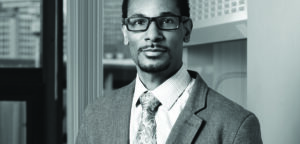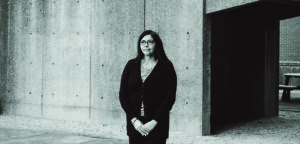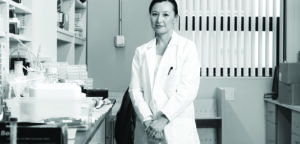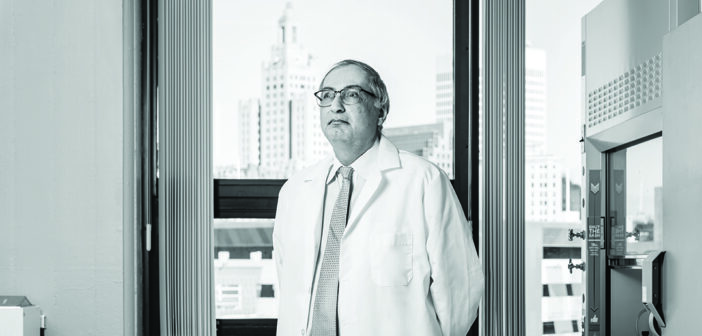The Legorreta Cancer Center is changing the prognosis for research and treatment in Rhode Island.
There’s a common thread in nearly every cancer patient’s story: with a few words from a trusted doctor, an entire future is rendered uncertain. Plans upended. Hopes shattered. The moment is less a diagnosis than an inflection point; an experience that inexorably changes the life of patients and the people closest to them.
In major metropolitan areas, patients often have plenty of treatment options to pursue. Enormous medical campuses devoted to cancer, like the famed MD Anderson center in Houston, exist in all but a handful of states. Until recently, that short list of holdouts included Rhode Island.
“Patients here typically had to travel north to Boston or south to New Haven and New York to get a high level of care,” says Wafik El-Deiry, MD, PhD, the associate dean for oncologic sciences. “That adds up to hours of travel, several times a week, which is not conducive to a good quality of life. We want to provide the latest care to them here at home.”
In 2019, El-Deiry came to Brown with the intent of solving that problem. Two years later, he became the founding director of the Cancer Center at Brown, a formal collaboration that joins the University’s leading scientific researchers with clinicians at two of the state’s largest hospital systems, Lifespan and Care New England. Last year, Brown received a $25 million gift from Brown Corporation member Pablo Legorreta P’21 and his wife, Almudena Legorreta P’21, for its support, and it was renamed the Legorreta Cancer Center.
Already, El-Deiry says, the existence of the cancer center has begun to shape new science, clinical trials, and treatment regimens in Rhode Island, and its researchers are diligently working to bring advances in care from the lab bench to patients.
“We want to understand everything we can about cancer within Rhode Island—and not just study it, but try to have impact on it,” El-Deiry says. “We have incredible academic researchers and clinicians here in the state. We have amazing technologies that weren’t available just a few years ago. And we have the ability to start addressing every aspect of cancer, right down to understanding it at the molecular level.”
IT TAKES A METROPOLIS
Moving cancer treatment forward isn’t just about finding new ways to kill cancer cells, says El-Deiry, who is also the Mencoff Family University Professor of Medical Science and a professor of pathology and laboratory medicine. It also involves understanding how those cells work, and figuring out why some existing treatments succeed while others fail.
Accomplishing those goals requires working across disciplines from molecular biology to oncology to data science—and one of the major reasons the Legorreta Cancer Center exists in the first place is to provide a formal framework for those collaborations.
“When it comes to caring for patients, it doesn’t take a village. It takes a city. A metropolis,” Alexander Raufi ’08 MD’13 says. It also takes people who act as a bridge between scientists at the University and caregivers at hospitals.
Like many of the cancer center’s team members, Raufi has a foot planted firmly on both sides of that bridge. A hematologist/oncologist at Lifespan and an assistant professor of medicine at Brown, he spends his days caring for patients with gastric and pancreatic cancers—many of which are devastating diseases with low survival rates—before diving into the lab to look for new treatments.

Sheldon Holder says his research informs the care he provides cancer patients, and vice versa. Photo by Adam Detour
That combination of day-to-day medicine with scientific research is key to saving patients in the long run, Raufi and his colleagues say. “It’s essential to keep your head in both worlds. Otherwise, you’ll silo your thinking,” says Sheldon Holder, MD, PhD, an assistant professor of pathology and laboratory medicine and an attending physician at the Lifespan Cancer Institute.
Holder treats genito-urinary cancers, which include kidney, prostate, and testicular tumors. What he sees in the clinic fuels his research in the lab, he says.
“Doing both helps me in both areas. When I’m seeing patients, it lets me identify what the problems are, and where the weaknesses are in our existing treatments,” he says. “It’s one thing to know in theory that we need better medications for prostate cancer. It’s another to see patients with advanced cancers, and you’ve tried all the treatments you can, but they’ve run out of options. That really helps focus my work in the lab.”
The inspiration that drives Holder and other scientists at the cancer center doesn’t just flow from the bedside to the bench. With each new discovery in the lab, researchers are able to set new clinical treatments into motion, filling gaps in existing care that could save the lives of patients in the future.
Biologist Michelle Dawson, PhD, studies how cancer cells metabolize lipids, a family of energy-rich molecules that make up fats, oils, and hormones. In her lab, the assistant professor of molecular biology, cell biology, and biochemistry strives to understand cancer on the cellular and molecular level. While that may seem a ways off from curing patients’ disease, she says, it’s a critical first step to finding new treatments—and input from clinicians is essential for moving her research in new directions.

Michelle Dawson’s research focuses on cancer at the cellular and molecular levels—a critical first step to finding new treatments. Photo by Adam Detour
“My expertise lets me identify questions to ask about cellular mechanisms, and set up experiments to test those questions. But I might not know how those cells’ behavior varies in patients, or how drugs that clinicians use will affect the basic cellular processes of a tumor,” Dawson says. “I don’t necessarily know which drugs they’re giving, the timing of the dosage, the markers they look for to see if the drug is effective in a patient. All that information can help me do better science.”
NEEDLES IN A TREATMENT HAYSTACK
In addition to basic research, cancer center scientists work to translate their findings into potential new drugs. El-Deiry developed one of those molecules, called ONC-201, at the Fox Chase Cancer Center at Temple University, and brought it with him to Brown. Here, he’s been able to continue testing its effects on inoperable brain tumors. So far, he says, things are looking good.
“ONC-201 has been one of the most exciting things in my career,” he says. “In clinical trials, it’s actually shrinking brain tumors in adults and children—these aggressive, middle-of-the-head tumors that you otherwise can’t reach. Usually, cancers like these have a horrible prognosis, and are very deadly.”
El-Deiry is now developing new variations of the drug. The latest version, ONC-212, uses a similar molecule as its predecessor, but adds atoms of fluorine to its structure that make the drug active in new parts of the body. Unlike ONC-201, which worked only in the brain, El-Deiry has shown that ONC-212 shrinks pancreatic tumors in the lab. It may one day do the same in humans.
That’s a pretty big deal, Alex Raufi says. “Chemotherapy for cancer was introduced in the 1960s. Since then, there have only been a handful of chemo regimens approved for pancreatic cancer—that’s despite almost 60 years of research,” he says. “We have a real opportunity to move the bar forward there.”
The infrastructure provided by the Legorreta Cancer Center is starting to bring its scientists closer to that goal. One of the center’s core facilities, a robotic drug screening system, lets researchers quickly and effectively test new drug substances on a huge array of cancer cells. In doing so, it provides data that can shape the trajectory of research.
“The robotic system gives us a very efficient tool for screening compounds. It lets us test up to 25,000 small molecules a day on a variety of cell types,” says Shengliang Zhang, PhD, assistant professor of pathology and laboratory medicine (research), who runs the facility. Once the device completes the tests, an integrated computer can scan the samples to see if any have changed, and will automatically flag promising ones for study.
In theory, the process sounds simple, Zhang says—but like so much in life, the real work is in the preparation. “First, you need to grow the right cells to test with each substance,” he says. “If you want to cast a broad net, you have to see if a compound works in lung tumors, pancreatic tumors, prostate cancer, and so on.”
Even within those categories, scientists have to then prepare a huge variety of different cells. In order to approximate whether a compound is clinically useful, Zhang says, it must be tested on tumor cells from a diverse range of people, of all ages and genders.
Recent work from El-Deiry’s lab underscores the importance of testing new drugs in multiple demographics. In 2020, his group found that the gene BRCA1, which is involved in repairing damage to DNA, seems to change its level of activity in people of different ages.
“Young patients with colon cancer seem to have a low expression of the gene, but not older patients. That could mean younger people have a deficiency of BRCA1,” El-Deiry says. If that’s the case, “it may be possible to find a new compound that increases BRCA1 expression, helping to prevent colon cancers before they start. There are a lot of future directions we can take from that information.”
TRIALS AND TRIBULATIONS
While basic science like this is essential for understanding how cancers work, El-Deiry notes that it’s just as important to get promising new findings from the lab into clinicians’ hands for testing. That’s because most existing cancers have only a few prescribed courses of treatment, like chemotherapy, surgery, radiation, immunotherapy, or some combination thereof. And if none of the existing treatments work, the only option left for some patients is to join a clinical trial of a new one.
These sorts of trials are an essential component of the work done at the cancer center, says Howard Safran, MD, medical director of the Brown University Oncology Group (BrUOG). “That’s how we make progress in research; you never know if something will work until you test it. Advances are made small steps at a time,” he says. For patients with late-stage cancer, those clinical trials could mean the difference between life and death.
Safran, a professor of medicine and the chief of hematology/oncology at the Lifespan Cancer Institute, has been with BrUOG almost continually since its founding in 1994. The group helps launch new studies, recruit patients, and compile data, with Safran providing a conduit between Brown researchers and area medical centers, where the drugs are actually tested. With BrUOG’s affiliation with the new cancer center, the number of clinical trials on the group’s docket may rise dramatically.
“It’s fantastic. Between the researchers at Brown and the oncologists at Lifespan and Care New England facilities, we have more than 50 people who are offering new ideas for treatment,” he says. “If all of them came up with just one idea every couple years, we’d still have enough to keep us busy.”
At the moment, BrUOG has more than a dozen trials underway in collaboration with the Legorreta Cancer Center. The more they can manage, the better it will be for patients in need, Safran says.

Wen-I Chang is an investigator in Wafik El-Deiry’s lab, in addition to her clinical work at Hasbro Children’s Hospital. Photo by Adam Detour
That way of thinking resonates deeply with researchers like Wen-I Chang ’03, MD, a pediatric oncologist and cancer geneticist at Brown and Hasbro Children’s Hospital.
“In pediatric solid tumors, the cure rate is only 60 percent. That means we lose almost half of our kids,” says Chang, an assistant professor of pediatrics, clinician educator. “The clinical trials that we’ve been able to open through the cancer center offer another chemotherapy regimen not offered anywhere else in the world. The fact that we can provide this to our patients is incredible.”
TAKING THE PULSE
The hope provided by clinical trials is a powerful draw for patients of the cancer center. Yet many communities in its own backyard still face disproportionate barriers, El-Deiry says.
“There are a lot of things that might prevent people from joining a clinical trial. It could be their past experience with cancer, their experience with health care, or their particular needs. All of that has to be addressed,” he says. “Some of the issues are socioeconomic, some are geographical—where people live—and some of them are cultural or language barriers. One of our major goals at the cancer center is to address those disparities, so that in the future, there are better outcomes for Rhode Islanders.”
Chipping away at cultural barriers can be particularly tricky, says Don S. Dizon, MD, the director of pelvic malignancies at the Lifespan Cancer Institute. “Clinical trials can be a sort of verboten thing in some cultures, where the general feeling is that they don’t want doctors to experiment on them,” says Dizon, a professor of medicine. In some cases, he notes, this can boil down to an issue of communication—so as part of his work with the cancer center, he’s using social media and other platforms to start a dialogue.
“It’s not enough just to educate people about cancer. It’s to get the pulse of a community,” he says. “Do they see access at Brown for clinical research and clinical care? And if they do, how can we improve things? What are they concerned about? How can we generate more trust within the institution and improve outcomes?”
Dizon thinks the process of engaging patients must be defined by their own social practices. For example, he says, “it would be a mistake to think you’d reach a predominantly Spanish-speaking community on Twitter.” Instead, conversations with leaders in those communities have revealed that traditional radio may be the best way to engage with Latinx residents of Providence.
Finding the right medium isn’t the only factor, however—sending the right message is also key. “If you go in and say, ‘learn about clinical trials in cancer,’ that’s going to fall flat,” Dizon says. “It has to be grounded in the disease that people have heard about, that they care about, or that they’re scared about. In Providence, that means you have to talk about bladder cancer first, and then bring up the innovative ways that the cancer center is looking at treating bladder cancer.”
That particular disease is especially prevalent in Rhode Island. Roughly 26 out of every 100,000 people in the state will develop bladder cancer, compared to the national average of about 20 out of 100,000. It may not seem like it, but that’s a significant difference, Dizon says—and to improve those outcomes, it will be essential to partner with the communities who suffer most from the disease.
“We want our research agenda to be informed by where community interest lies. It’s really a bidirectional feedback loop,” he says. “It will be hugely important that the cancer center works to be a part of that community, rather than a white tower that people visit only when they need to.”
In many ways, that goal of serving the whole state—and making care accessible to all within it—seems to drive everyone at the Legorreta Cancer Center. Raufi, who grew up in Rhode Island, feels a deep personal connection to his work, and after residency and fellowship in California and New York, he made it a priority to return home as a physician.
“Rhode Island is a very tight-knit community,” he says. “Within a few degrees of separation, you’ll know someone or have a connection to them. Caring for your neighbors means so much. These people’s lives touch you in a way, and you form a bond more quickly.”
Fostering relationships between caregivers, patients, and colleagues may ultimately be one of the deciding factors in how the cancer center thrives. Building those bonds, after all, offers a linchpin for creating new science, new understanding, new treatments—and most importantly, new hope for everyone involved.
“It says it right there on the state flag,” Raufi says. “If you don’t have hope, what do you have?”




